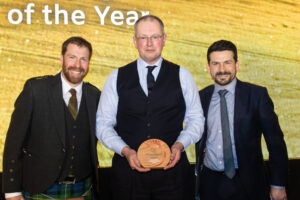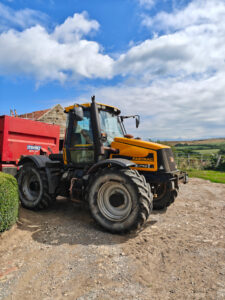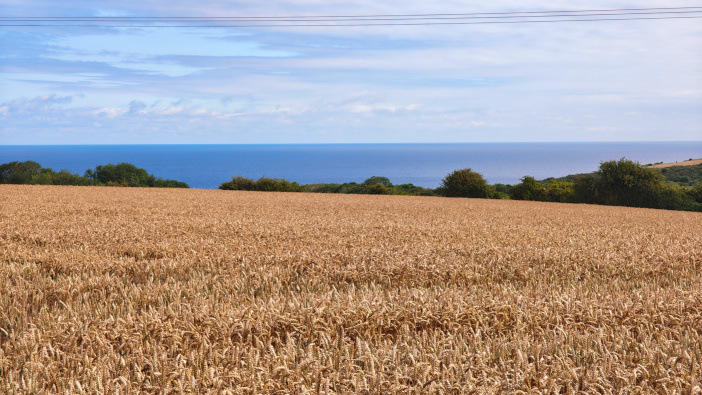Winner of the 2025 Protein Crop Grower of the Year, Guy Prudom continues to look at new ways to build efficiency on the family farm
When we pull up to P Prudom & Son Ltd, located right on the coast just north of Whitby, with Boulby Mine – the UK’s deepest mine – a little further up the coast, Guy has just finished the oilseed rape harvest. Oilseeds were added after the farm came out of organic production, with Guy recognising the need to widen the rotation to build greater resilience and soil health.
It’s just one of the many changes the business has made since the 1960s, when Guy’s grandfather took on just over 121ha in a tenancy with the Mulgrave Estate. For nearly thirty years, the farm utilised a plough-based arable system, with a beef finishing unit. In the late 80s, Guy’s parents, Peter and Christine, decided to add a beef suckler herd to run alongside the finishing unit.
“By the time I joined the business in 1994, the farm was up to 182ha, with just over 100ha down as arable,” Guy explains. “We were also getting up to capacity with the herd, with 90 Continental Simmental crosses here at the home farm.”
He says that he had one goal when he came back to the farm: to be farming more than 400ha, and he quickly saw a niche in areas of grassland that became available. “We took on a five-year farm business tenancy agreement for 52ha, which not only provided enough pasture to increase the herd, but a series of buildings to house them.”
Up until 2004, the business continued to add ground to the farm through a series of FBTs and rentals until they reached 526ha, and the herd was pushed up to 250 sucklers, with a further 550 head of youngstock and finishing cattle. While he’d achieved his goals, Guy says that yields had plateaued and were dropping in some cases, and reforms to the Common Agricultural Policy (CAP) would impact income on the farm.
 “It was clear we needed to do something that would add a premium to what we produced and would also allow us to focus on soil health,” he explains.
“It was clear we needed to do something that would add a premium to what we produced and would also allow us to focus on soil health,” he explains.
Farming organically
Guy says the switch to organic production in 2004 taught him and his parents how to farm again. “After continuous winter cereals, all crimped and fed back to the finishing cattle, we were overrun with ryegrass and brome, and while we were establishing crops with minimum tillage, it was not in the most efficient way.”
The first step was to broaden the rotation. Cereals were still the core of the programme, but Guy introduced red clover leys and cover crops into the system. “The plough provided us good weed control and allowed us to cycle the nutrients within the soil,” he says. “It was pretty clear that we weren’t struggling for soil fertility; we’d just ignored the benefits of a strong rotation.”
Cover crops also helped keep nutrient levels just high enough to continue producing a viable yield. Reduced cattle numbers didn’t produce enough manure to put back into the soil, so these were key to sequestering nitrogen and building a rooting system for the next crop.
Following advice from Kelvin Cave, Guy added another crop into the rotation in 2008. Spring beans were trialled on the farm with a view to wholecrop them and replace imported organic soya in the ration. Guy says that they’ve never looked back from this point.
The beans not only added some much-needed diversity to the rotation, but the fact that they were being wholecropped meant that weeds were picked up and exported off the field, without dropping seeds into the soil.
As the majority of the crops were used as feed for the herd, it was the beef cattle where the premiums were to be found. The farm became a producer for Dovecote Park, itself a supplier to Waitrose. Combined with rotational grazing and a new vaccination regime, Guy notes that the system became more efficient and more profitable.
However, in 2017, they made the decision to drop their organic certification. This was partly driven by a drop in organic premiums, but Guy also notes that their sandy and silt soils weren’t getting enough put back in to maintain strong yields.

How they farmed didn’t change that much, though. Guy didn’t want to move backwards, but take what they had learnt from farming organically and expand on it with a wider array of tools. “We did trial some old techniques again, such as applying insecticides for the first three years, but quickly found that we were only achieving about 30% efficacy in oilseeds,” he says. “We started mixing in biostimulants from Soil Fertility Services, which helped the crops naturally battle pests, and then dropped insecticides altogether without any increase in damage.”
The rotation was expanded further. Oilseed rape was added for the first time in 16 years, leading to some bumper yields and more complex cover crop mixes. The rotation now starts with winter barley, crimped three to four weeks ahead of normal harvesting times, followed by an application of manure and gypsum. Oilseed rape is then stitched in, followed by winter wheat.
The first cover crop goes in after the wheat, made up of forage rye and westerwolds, which is wholecropped for the cattle, often achieving around 17t/ha. A spring barley crop goes in after this, followed by another cover of black oats, mustard, stubble turnips and westerwolds, which dies off in January ahead of spring beans. A final winter wheat crop goes in before the cycle starts again.
“We’ve seen a huge increase in biomass, both as a viable feed for the cattle and as organic matter that can be turned back into the soil,” Guy explains. “Soil health has improved dramatically and we’re achieving significantly higher yields.”
 New methods
New methods
There’s also been a shift from a wholescale plough system. A neighbouring contractor invested in a Mzuri strip-till drill, and Guy brought him in to sow the rotation. Between the increased biomass and reduced soil movement, Guy says the efficiency of the system and the drivability of the fields have improved. “We’re also able to establish the cover crops using a seeder box on the back of the Mzuri.”
Muckspreading and spraying are also handled by contractors, with the farm shifting to liquid nitrogen, something Guy says has reduced application rates by around 25%. Foraging is also contracted out, minimising the capital investment on the farm.
“We recently invested in a Massey Ferguson 7718S, which arrived in February, and this is the frontline tractor, backed up by a JCB Fastrac 2140 with 10,500hrs on the clock,” he says.
They also handle their own combining, with a 2005 MF 7278 Cerea, and there are two Merlo telehandlers spread across the sites, both clocking up over 10,000hrs, along with an old Matbro TS280, with 16,000hrs. Guy jokes that this ‘refuses to die’.
Other implements, including a batwing mower and a grassland subsoiler, have been purchased, but Guy notes that they are spoiled for good quality contractors in the area.
“Our local operator also hires out equipment, which means we can tackle pretty much any job we need to if there’s an issue with timings.”
Guy does note, though, that he’s looking at streamlining parts of the farm, as his parents look to retire. “We don’t have quite enough work to justify hiring someone full-time, but probably too much work for one person to comfortably do on their own,” he explains.
The farm area is being cut back slightly, bringing it back below Guy’s initial aim of 400ha. They’ve also started reducing the herd, which peaked at 250 sucklers in 2004, and is down to 150 plus followers. From 2026, the farm will house around 90 sucklers, with 50 replacement heifers and finishing cattle.
“I’m researching ways that we can add value to the heifers,” he says. “And we’ll probably use the additional space for contract rearing, which will boost the income and provide additional manure for the crops.”
Similarly, the cropping area will be based on output, rather than scale. Guy says that he’s looking at precision farming systems to match inputs to the predicted yield and avoid overspend. “I’d also like to incorporate compost into the rotation to increase microbial activity in soil and root development.”



